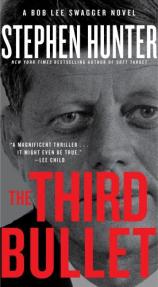The Third Bullet: A Bob Lee Swagger Novel
Review
The Third Bullet: A Bob Lee Swagger Novel
I have long admired Stephen Hunter’s ongoing saga concerning the Swagger family, particularly that portion dealing with Bob Lee Swagger, the master Marine sniper known as “Bob the Nailer.” Given that Swagger is now in his mid-60s, Hunter wisely has reduced the character’s physical activity, though his prominence in these books haven’t diminished. THE THIRD BULLET continues Swagger’s role as a detective and investigator that started in 2010’s DEAD ZERO.
"Some of Hunter’s best writing can be found here, along with new revelations about Swagger that are…touching. Then, of course, there is the investigation into Kennedy’s death on that fateful day in Dallas and its conclusions. Hunter raises some thought-provoking questions..."
As may be immediately obvious to those of a certain advanced age or with an interest in American history, the book’s title originates from part of the puzzle that continues to surround John F. Kennedy’s assassination. Things begin interestingly enough with the murder of an assassin researcher via a hit-and-run incident. The dead man’s widow seeks out the semi-reclusive Swagger, who at first --- knowing less than the reader and thus entertaining the possibility that the investigator’s death could have been a tragic accident --- is disinclined to involve himself in either the investigation of the man’s death or his research into the assassination.
At the last minute, though, the widow almost offhandedly gives Swagger an additional, seemingly minor piece of information that causes him to do a 180, attitude-wise, and to immediately begin retracing the dead researcher’s footsteps. The info has a link to part of Swagger’s past, one documented in 1993’s POINT OF IMPACT. Swagger’s trail takes him to Dallas, where his extensive undercover research draws some extremely unwelcome attention, then to Russia and back to the states, where events slowly play themselves out to a dramatic and cataclysmic conclusion.
Hunter’s exhaustive reverse-engineering of the assassination through the eyes of his iconic character will be well-received by that portion of his audience who is as interested in the topic and, more importantly, as versed in the event and the details surrounding it as he is. That would include myself, who watched the events of November 22, 1963 unfold and studied it to various degrees ever since. For others, who may have only a passing interest, if any, in the controversy, the book may be a tough sell.
Even for those of us who are students of and participants in the use of firearms, Hunter’s passion for detail occasionally gets in the way of the plot. There’s no question that he gets it right, but at some point, I found myself reading the details of this or that rifle or shotgun more out of respect and obligation for the author’s research and sense of duty than to follow the story. Others might not be so inclined.
About midway through the book, the man behind the curtain --- the one who was responsible for sparking the catalyst in Dallas a half-century ago and who feels the hot pursuit of the undercover Swagger on his neck in the present --- inserts himself in the narrative in the first person through the medium of a written memoir, which then proceeds alternatively with the third-person omnipresent observations of Swagger as his investigation draws him ever closer to his prey and thus to danger. Although an interesting narrative device, it doesn’t always work.
While not the best book in the series, THE THIRD BULLET is still a good one and I recommend you read it, even if getting through parts of it is like a six-mile, stiff-legged march through high sand. Some of Hunter’s best writing can be found here, along with new revelations about Swagger that are…touching. Then, of course, there is the investigation into Kennedy’s death on that fateful day in Dallas and its conclusions. Hunter raises some thought-provoking questions, and while the “who” in the equation may still be in doubt, the answers to the “what” and “how” may be contained in this work, which is labeled as “fiction” but could be much more.
Reviewed by Joe Hartlaub on January 17, 2013





